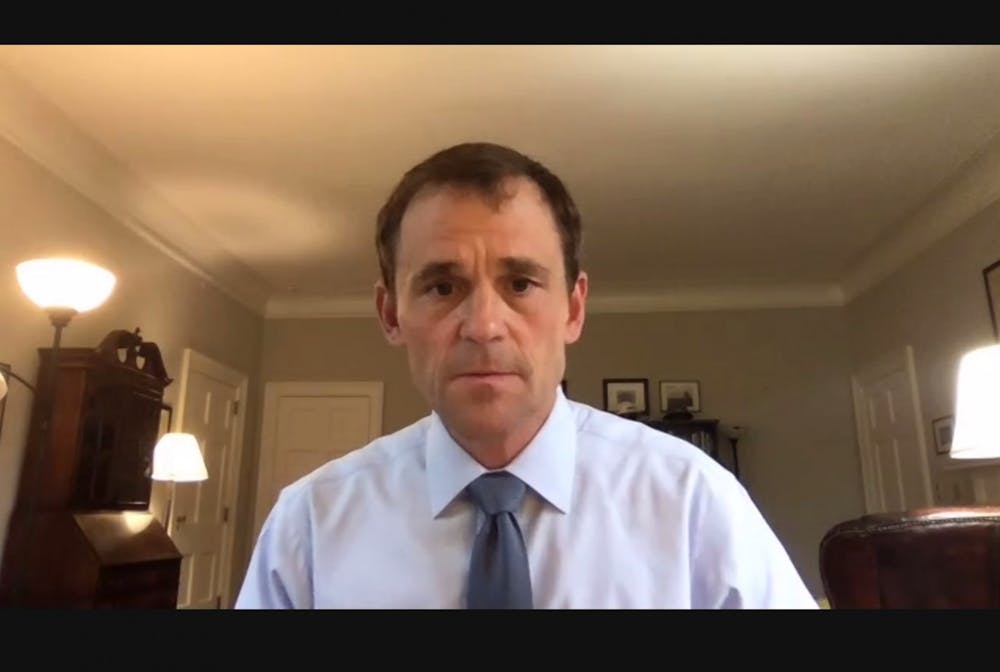University President Jim Ryan and J.J. Davis, chief operating officer and chair of the University’s housing advisory group, met with members of the community in an hour-long Zoom session Thursday to kick off the community engagement effort for the University’s affordable housing initiative, which will support the development of over 1,000 low-cost units in the local community.
Gina Merritt — a consultant for Northern Real Estate Urban Ventures, a community development organization that is engaged in a holistic approach to real-estate development in low-income communities — provided an overview of the initiative and helped answer questions. Community members were able to submit questions while registering for the event and during the event via the chat function.
Announced in March 2020, the University’s affordable housing initiative promises to support the development of 1,000 to 1,500 housing units in Charlottesville and Albemarle County over the next 10 years. Though plans were paused shortly after the announcement due to the COVID-19 pandemic, Thursday’s event marked a recommitment to this goal.
As part of the plan, the University will contribute land owned by the U.Va. Foundation and partner with third-party developers. The location of the first batch of homes has not yet been chosen, as community feedback will play an important role in that decision.
In his opening remarks, Ryan emphasized the University’s commitment to serving the community, of which the new initiative is only a part.
“There is a complicated and not entirely happy history of development in Charlottesville, including U.Va.’s role in it,” Ryan said. “Financial profit is not at all our driver and our goal has the support of the Board of Visitors and the entire leadership team of the University.”
The city of Charlottesville previously bulldozed Vinegar Hill, a historically Black neighborhood, in the name of an urban renewal project in 1964. While the city said the point of the demolition was to free the flow of traffic between the University and the Downtown Mall, nothing has been done yet with the land.
Addressing concerns that the student market pressure can cause high rents throughout the city, Ryan said that the University has not yet decided whether to exclude those associated with the University from occupying the units.
“Given the connection between the community and those who work at U.Va., I would imagine it would be open,” he said.
In a 2010 report, 57 percent of students lived off Grounds — overwhelmingly in rental units. In a 2019 survey among Charlottesville residents conducted by Ryan’s Community Work Group, many respondents expressed dismay that students were occupying more space in surrounding neighborhoods and thus making these neighborhoods more unaffordable for permanent residents.
Ryan said that another of the University’s goals is to provide enough housing for all second-year students to live on Grounds. The University administration has previously said that it will require second-years to live on Grounds in the future, though an increase in on-Grounds housing units are needed to do so. Currently, all first-year students are required to live on Grounds in dorms, while upperclass students may live off Grounds or in University-sponsored upperclass housing.
“My hope is that we will get to a point where we can require first and second years to live on Grounds, which I think would be good for them, but I also think it would help alleviate some pressure on the local housing market,” Ryan said.
In response to an anonymous question about how the project will fit into the affordable housing work being done by other organizations in the community, Merritt acknowledged the importance of complementing these efforts without duplication.
“If everyone is trying to create a solution for one small segment of the people who are affected by a lack of affordable housing, there will be a lot of people who aren’t helped,” Merritt said.
In January, the Charlottesville Planning Commission endorsed a project to develop the historically Black Fifeville neighborhood, which is being spearheaded by the Thomas Jefferson Planning District Commission. The plan includes construction of new housing in the corridor along with improvements to road safety and access to an affordable grocery store.
Merritt said she hopes the University’s initiative can learn from projects like these.
“I will be meeting with local organizations, neighborhoods and city and county officials [over the next two months],” Merritt said. “Both the city and county are represented on the advisory group for the project along with local organizations … [so] we will have plenty of interaction with those folks.”
Among the organizations Merrit hopes to meet with are those that work with the unhoused population in the Charlottesville community. As of 2018, there were 136 people in shelters or transitional housing and an estimated 20 to 30 people unsheltered in the Charlottesville area, according to a Point-in-Time Count by the Thomas Jefferson Area Coalition for the Homeless. The COVID-19 pandemic has put even greater stress on the community’s homeless, as shelters have needed more space to allow for proper social distancing.
“We understand that people who need affordable housing are not all the same and they face unique challenges based on their individual circumstances,” Merritt said.
Pointing to work already underway, Ryan cited the Charlottesville Area Community Foundation’s acquisition of a 3.75-acre property in Albemarle County for the development of a permanent shelter. Currently the site of a Red Carpet Inn, the county Board of Supervisors approved the rezoning of the property in February. In April, the CACF — to which the University is a contributor — made a $4.25 million grant for the purchase of the land.
“I have thought for a long time that Charlottesville really needed to take on the issue,” Ryan said. “There hasn’t been up to this point a designated overnight homeless shelter, and so I think this is an incredibly important step, which is why we’ve supported it.”
In response to a question about the proximity of the new housing units to amenities and transportation, Ryan said that location is one of the most important considerations the initiative must take into account.
“I don’t know much about real estate, but I do know the old saying about location, location, location, and that’s as true of affordable housing as [it is] of anything else,” Ryan said. “We’ve been focusing on [sites] that are either walking distance to amenities or on a transportation line.”
Merritt said that another important factor in site selection is proximity to employment centers and possible opportunities for wealth development projects.
“[We are] trying to figure out where in the whole portfolio of land that the University owns there is an opportunity to offer home ownership to help [residents] grow wealth,” Merritt said.
In an anonymous poll conducted during the meeting, 61 percent of viewers chose affordability as the most important aspect of the new housing initiative while 30 percent chose location. When given a choice of possible amenities, 42 percent of viewers chose access to community services as the most important while 24 percent chose green and outdoor gathering spaces. In the final poll, 89 percent of viewers supported the development of affordable housing on University property while 3 percent were opposed.
Addressing a comment from an anonymous donor to the University during the meeting about whether individual donations would be used toward the affordable housing project, Davis clarified that donor funds would not be used.
“U.Va. will be offering capital in terms of human capital, but the main idea here is that we will offer land, which will reduce the overall cost of producing the housing which will in turn make it affordable,” Ryan said.
In his final remarks, Ryan restated the importance of the University’s connection to the surrounding communities.
“I believe strongly that U.Va. and our neighbors in Charlottesville and Albemarle County … are linked together and our fates are tied together,” he said. “[Contributing] to increasing the supply of affordable housing is one part of that.”
The project will be a step towards fulfilling the goals of the University’s Good Neighbor Program -- Part of the University’s 2030 plan -- which promises to partner with the surrounding communities to address challenges including housing, living wages, local educational opportunities and access to healthcare.







